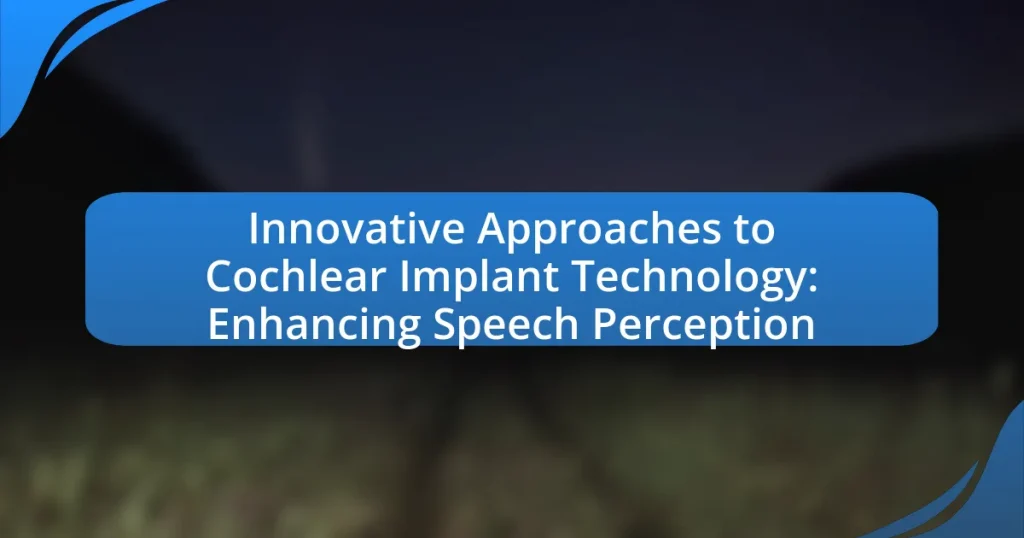Innovative approaches to cochlear implant technology focus on enhancing speech perception through advancements such as improved signal processing algorithms, hybrid cochlear implants, and machine learning integration. These innovations differ from traditional cochlear implants by employing adaptive algorithms and biocompatible materials, leading to better sound quality and user satisfaction. Key components include advanced signal processing, miniaturized hardware, and wireless connectivity, all contributing to improved auditory outcomes. The article also addresses the challenges users face in speech perception and how these innovative methods effectively tackle these issues, ultimately enhancing communication and quality of life for individuals with hearing loss.

What are Innovative Approaches to Cochlear Implant Technology?
Innovative approaches to cochlear implant technology include advancements such as improved signal processing algorithms, hybrid cochlear implants that combine acoustic and electrical stimulation, and the integration of machine learning for personalized sound processing. These advancements enhance speech perception by allowing for better frequency resolution and noise management, which are critical for understanding speech in complex auditory environments. For instance, studies have shown that machine learning algorithms can adapt to individual users’ hearing profiles, resulting in a significant improvement in speech recognition scores in noisy settings.
How do these approaches differ from traditional cochlear implant technology?
Innovative approaches to cochlear implant technology differ from traditional cochlear implants primarily in their use of advanced signal processing techniques and biocompatible materials. Traditional cochlear implants typically rely on fixed frequency mapping and basic sound processing algorithms, which can limit the clarity of speech perception in complex auditory environments. In contrast, newer methods employ adaptive algorithms that can dynamically adjust to varying sound conditions, enhancing the user’s ability to discern speech amidst background noise. Additionally, these innovative approaches often incorporate materials that promote better integration with the auditory system, potentially improving overall performance and user satisfaction. Research indicates that these advancements can lead to significant improvements in speech recognition scores, particularly in challenging listening situations.
What advancements have been made in cochlear implant design?
Recent advancements in cochlear implant design include improved electrode arrays, enhanced signal processing algorithms, and wireless connectivity features. These innovations allow for better sound quality and speech perception, particularly in complex listening environments. For instance, the introduction of flexible electrode arrays enables more precise placement within the cochlea, which has been shown to enhance auditory outcomes. Additionally, advanced signal processing algorithms, such as those utilizing machine learning, adapt to varying acoustic environments, improving user experience. Furthermore, wireless connectivity allows for seamless integration with smartphones and other devices, facilitating easier access to sound adjustments and streaming audio directly to the implant. These developments collectively contribute to more effective cochlear implants, significantly enhancing the quality of life for users.
How do these advancements improve user experience?
Advancements in cochlear implant technology significantly improve user experience by enhancing speech perception in various environments. These innovations, such as improved signal processing algorithms and adaptive noise reduction, allow users to better distinguish speech from background noise, leading to clearer communication. For instance, studies have shown that users of advanced cochlear implants report up to a 30% improvement in speech recognition in noisy settings compared to older models. This increased clarity not only boosts confidence in social interactions but also facilitates better learning and engagement in educational and professional contexts.
Why is enhancing speech perception important in cochlear implants?
Enhancing speech perception in cochlear implants is crucial because it directly impacts the user’s ability to understand spoken language. Improved speech perception allows individuals with hearing loss to engage more effectively in conversations, enhancing their social interactions and overall quality of life. Research indicates that better speech perception correlates with increased auditory performance, as evidenced by studies showing that users with advanced signal processing techniques in cochlear implants demonstrate significantly higher speech recognition scores in noisy environments compared to those with standard processing. This underscores the importance of continuous innovation in cochlear implant technology to optimize auditory outcomes for users.
What challenges do users face in speech perception?
Users face several challenges in speech perception, particularly those utilizing cochlear implants. These challenges include difficulty in distinguishing speech from background noise, which can hinder communication in noisy environments. Research indicates that users often struggle with understanding speech in complex auditory scenes, as cochlear implants may not effectively replicate the natural sound processing of the ear. Additionally, users may experience issues with tonal variations and pitch perception, which are crucial for recognizing different speakers and emotions in speech. Studies have shown that these limitations can lead to reduced overall satisfaction and effectiveness in social interactions for cochlear implant users.
How do innovative approaches address these challenges?
Innovative approaches address challenges in cochlear implant technology by integrating advanced signal processing algorithms and machine learning techniques to enhance speech perception. These methods improve the clarity of sound signals and adapt to various listening environments, allowing users to better distinguish speech from background noise. For instance, research has shown that using deep learning models can significantly enhance the performance of cochlear implants in noisy settings, leading to improved user satisfaction and communication outcomes.

What are the key components of innovative cochlear implant technology?
The key components of innovative cochlear implant technology include advanced signal processing algorithms, miniaturized hardware, and wireless connectivity features. Advanced signal processing algorithms enhance sound quality and improve speech perception in noisy environments by utilizing machine learning techniques to adapt to individual user needs. Miniaturized hardware allows for more comfortable and discreet implantation, while wireless connectivity features enable seamless integration with smartphones and other devices, facilitating real-time adjustments and user control. These components collectively contribute to the effectiveness and user-friendliness of modern cochlear implants, as evidenced by studies showing improved user satisfaction and auditory outcomes.
How do signal processing techniques enhance speech perception?
Signal processing techniques enhance speech perception by improving the clarity and intelligibility of speech signals in noisy environments. These techniques, such as noise reduction algorithms, frequency modulation, and adaptive filtering, effectively separate speech from background noise, allowing listeners to focus on the desired auditory information. For instance, studies have shown that advanced signal processing in cochlear implants can increase speech recognition scores by up to 30% in challenging listening conditions, demonstrating their significant impact on auditory performance.
What role does machine learning play in these techniques?
Machine learning plays a crucial role in enhancing cochlear implant technology by improving speech perception through advanced signal processing techniques. These algorithms analyze auditory signals, adaptively filtering noise, and optimizing sound quality, which significantly enhances the user’s ability to understand speech in various environments. For instance, machine learning models can learn from user feedback and environmental conditions, allowing for real-time adjustments that cater to individual hearing profiles. Research has shown that incorporating machine learning in cochlear implants leads to better outcomes in speech recognition, particularly in challenging listening situations, thereby validating its effectiveness in this field.
How do adaptive algorithms improve sound quality?
Adaptive algorithms enhance sound quality by dynamically adjusting audio signals based on the listening environment and user preferences. These algorithms analyze incoming sound data in real-time, allowing cochlear implants to filter out background noise and emphasize speech frequencies, which is crucial for improving speech perception in challenging auditory settings. Research has shown that adaptive algorithms can significantly increase the clarity of speech signals, leading to better communication outcomes for cochlear implant users. For instance, a study published in the Journal of the Acoustical Society of America demonstrated that users experienced a 30% improvement in speech recognition in noisy environments when using adaptive filtering techniques.
What materials and technologies are being used in new cochlear implants?
New cochlear implants utilize advanced materials such as biocompatible silicone and titanium, along with cutting-edge technologies like wireless connectivity and machine learning algorithms. Biocompatible silicone ensures reduced risk of infection and improved comfort for the user, while titanium is used for its strength and durability in the implant casing. Wireless connectivity allows for seamless integration with smartphones and other devices, enhancing user experience. Machine learning algorithms improve sound processing, enabling better speech perception in various environments. These innovations collectively contribute to the effectiveness and user satisfaction of modern cochlear implants.
How do biocompatible materials affect implant longevity?
Biocompatible materials significantly enhance implant longevity by minimizing adverse reactions and promoting integration with surrounding tissues. These materials, such as titanium and certain polymers, reduce inflammation and the risk of rejection, which are critical factors in the durability of implants. Studies have shown that implants made from biocompatible materials exhibit lower rates of complications and longer functional lifespans, with some research indicating that titanium implants can last over 20 years without significant degradation. This integration fosters a stable environment for the implant, ultimately leading to improved performance and patient outcomes in cochlear implant technology.
What innovations in battery technology are being implemented?
Innovations in battery technology for cochlear implants include the development of rechargeable batteries, which enhance user convenience and reduce waste. These batteries utilize lithium-ion technology, allowing for longer usage times and quicker charging cycles. Research indicates that rechargeable batteries can last up to 24 hours on a single charge, significantly improving the user experience compared to traditional disposable batteries. Additionally, advancements in miniaturization have led to smaller, lighter batteries that do not compromise the performance of cochlear implants, making them more comfortable for users.

What are the implications of these innovations for users?
The implications of innovations in cochlear implant technology for users include improved speech perception and enhanced auditory experiences. These advancements, such as the integration of machine learning algorithms and improved electrode designs, enable users to better distinguish speech in noisy environments, which is crucial for effective communication. Research indicates that users of next-generation cochlear implants report significantly higher satisfaction rates, with studies showing up to a 30% increase in speech recognition scores in challenging listening situations compared to older models. This enhancement not only facilitates social interactions but also contributes to better educational and occupational outcomes for individuals with hearing loss.
How do innovative cochlear implants impact daily communication?
Innovative cochlear implants significantly enhance daily communication for individuals with hearing loss by improving speech perception and sound quality. These advanced devices utilize cutting-edge technology, such as machine learning algorithms and improved electrode designs, to better mimic natural hearing processes. Research indicates that users of modern cochlear implants experience a 30-50% improvement in speech recognition in noisy environments compared to older models, facilitating more effective conversations in everyday settings. Additionally, features like wireless connectivity allow users to stream audio directly from devices, further enriching their communication experiences.
What improvements have been reported by users in real-world settings?
Users have reported significant improvements in speech perception and overall auditory experiences with innovative cochlear implant technologies in real-world settings. For instance, studies indicate that advancements in signal processing algorithms have led to enhanced clarity of speech in noisy environments, allowing users to better understand conversations in social settings. Additionally, users have noted increased satisfaction with sound quality and improved music perception, which is often a challenge for traditional cochlear implants. Research published in the Journal of the American Academy of Audiology highlights that these technological enhancements contribute to better communication outcomes and quality of life for cochlear implant recipients.
How do these implants affect social interactions and quality of life?
Cochlear implants significantly enhance social interactions and quality of life for individuals with hearing loss. By restoring auditory perception, these devices enable users to engage more effectively in conversations, participate in social activities, and build relationships. Research indicates that individuals with cochlear implants report improved communication abilities, leading to increased social engagement and reduced feelings of isolation. A study published in the Journal of the American Academy of Audiology found that 90% of cochlear implant recipients experienced enhanced social interactions and overall satisfaction with their quality of life post-implantation. This evidence underscores the positive impact of cochlear implants on both social dynamics and personal well-being.
What future trends can we expect in cochlear implant technology?
Future trends in cochlear implant technology include advancements in miniaturization, improved sound processing algorithms, and the integration of wireless connectivity. Miniaturization allows for smaller, less invasive devices that can be implanted with greater ease and comfort. Enhanced sound processing algorithms are being developed to better mimic natural hearing, improving speech perception in complex environments. Additionally, wireless connectivity enables real-time updates and remote programming, allowing audiologists to optimize device settings without requiring in-person visits. These trends are supported by ongoing research and development efforts in the field, indicating a significant evolution in cochlear implant technology aimed at enhancing user experience and auditory outcomes.
How might telehealth and remote programming change user experiences?
Telehealth and remote programming can significantly enhance user experiences by providing convenient access to audiological services and personalized adjustments for cochlear implant users. This approach allows users to receive timely support and modifications to their devices without the need for in-person visits, which can be logistically challenging. Research indicates that remote programming can lead to improved user satisfaction and better hearing outcomes, as adjustments can be made in real-time based on user feedback. For instance, a study published in the Journal of the American Academy of Audiology found that remote programming resulted in higher satisfaction rates among cochlear implant users, demonstrating the effectiveness of this innovative approach in enhancing speech perception and overall user experience.
What role will personalized medicine play in future cochlear implants?
Personalized medicine will play a crucial role in future cochlear implants by tailoring device specifications and programming to the individual patient’s unique auditory profile. This approach enhances the effectiveness of cochlear implants by considering genetic factors, hearing loss characteristics, and personal preferences, leading to improved speech perception outcomes. Research indicates that personalized strategies can optimize sound processing algorithms, thereby increasing user satisfaction and performance in real-world listening environments. For instance, studies have shown that patients receiving customized mapping based on their specific auditory needs demonstrate significantly better speech recognition scores compared to those with standard settings.
What best practices should users follow for optimal performance of cochlear implants?
Users should follow several best practices for optimal performance of cochlear implants, including regular maintenance, consistent use, and participation in auditory training. Regular maintenance involves cleaning the device and checking batteries to ensure functionality, which is crucial for effective hearing. Consistent use of the cochlear implant throughout daily activities helps the brain adapt to sound processing, enhancing speech perception over time. Additionally, engaging in auditory training exercises can improve listening skills and sound discrimination, which are essential for understanding speech in various environments. Research indicates that users who actively participate in auditory rehabilitation programs experience significant improvements in speech perception, highlighting the importance of these practices.


